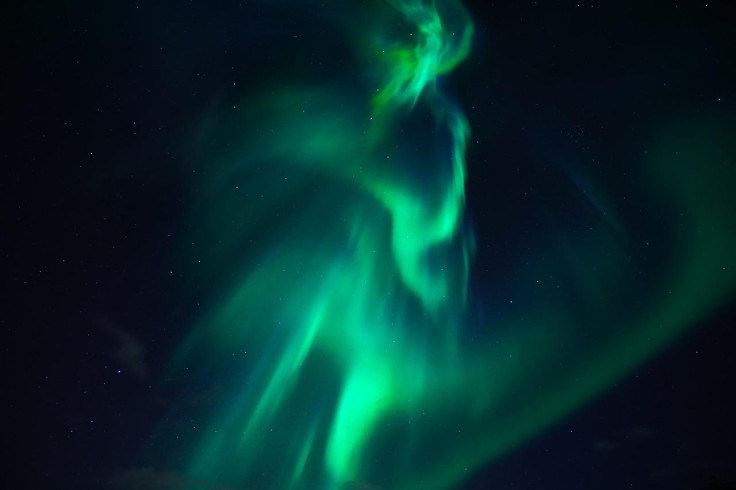LOOK: Powerful Eruption On Sun Triggers Stunning Auroras Across The World
KEY POINTS
- NASA shared a view of the CME that erupted and arrived on Earth
- The resulting geomagnetic storm was stronger and arrived faster than anticipated, as per SWPC
- Many people witnessed auroras and shared the views that they captured
A geomagnetic storm hit the Earth over the weekend, and NASA instruments captured a view of the powerful eruption. Here on Earth, all eyes were also on the skies, as many captured stunning views of the resulting auroras.
The "severe" geomagnetic storm hit the Earth at 1:37 p.m. EDT on Sunday, according to the National Oceanic and Atmospheric Administration's (NOAA) Space Weather Prediction Center (SWPC). This came after a solar flare erupted from the Sun and spewed billions of tons of plasma in an eruption known as a coronal mass ejection (CME).
NASA shared footage of the massive eruption, as captured by the Solar Dynamics Observatory (SDO) and the NASA/ESA Solar and Heliospheric Observatory (SOHO) — both being instruments that are keeping a constant watch on the Sun.
The short footage shows a combination of the two instruments' views, with the center footage being from the SDO, and the two others being from the SOHO. It clearly shows how the eruption from the Sun spewed outward into space, proving just how powerful such eruptions can be.
The storm came from a powerful coronal mass ejection, or CME, that erupted from the Sun on Friday and reached Earth yesterday.
— NASA Sun & Space (@NASASun) April 24, 2023
Here’s a view of the CME combining observations from NASA’s Solar Dynamics Observatory (center) and two views from NASA/ESA’s SOHO (periphery). pic.twitter.com/5FIRPIYFpk
The CME traveled with speeds of 2 million miles per hour to reach the Earth, the SWPC explained, adding that it "arrived earlier and was stronger than expected."
Among its impacts on the planet were the stunning auroras that resulted from the particles from the Sun hitting the Earth's magnetic field. These events were expected to be seen further south than usual. And indeed, many people across the planet captured stunning views of the event.
In the U.S., auroras were seen as south as Arizona, according to NASA. The image it shared on Twitter was one taken from Utah, showing the lovely purple and green hues splashed across the sky.
We had a whopper of a space weather storm this weekend! Around 2pm EDT on Sunday, a powerful geomagnetic storm kicked off and later that evening, viewers as far south as Arizona reported seeing auroras!
— NASA Sun & Space (@NASASun) April 24, 2023
This photo was taken by Bill Dunford in Utah. pic.twitter.com/UVB3DRiAdZ
Another stunning view of the auroras came from northwestern Illinois, where the lights appeared to be particularly mesmerizing.
INCREDIBLE electron precipitation in northwestern Illinois last night. I can’t believe this happened above my head! I will never forget this G4 storm! #northernlights #aurora #illinois @spacewxwatch @NightLights_AM @TamithaSkov pic.twitter.com/ouiCITkkBu
— Landon Moeller (@landon_wx) April 24, 2023
Elsewhere on the planet, even viewers in New Zealand caught a glimpse of the event, where the beautiful lights of the aurora were still quite clearly visible despite the cloud cover.
Clouds and Aurora not the best mix in Southland New Zealand. @TamithaSkov . We are catching the tail end of this CME I think. #aurora. pic.twitter.com/y0xcAcZzbi
— Edwin Mabonga 🧢 (@Edwinmab1) April 24, 2023
The view was also quite impeccable in West Kazakhstan, where the colors appeared to be extra vivid.
Aurora Lights last night over West Kazakhstan region (51 latitude) @NightLights_AM #AuroraBorealis pic.twitter.com/WEHeNxEgsG
— Eнот (@worst_raccoon) April 24, 2023
A particularly gorgeous view from the U.K. even displays short footage of the event, showing the rather otherworldly greenish and purple lights dancing across the sky.
Aurora Borealis over the UK ✨🤯
— Astro Ben 📸✨ I take photos of space 🔭 (@bbroastro) April 23, 2023
This is the strongest Aurora I have ever seen and captured. #astronomy #aurora #AuroraBorealis #space #weather pic.twitter.com/y1hKHAmt7c
Indeed, this particular geomagnetic storm gave many viewers from across the world some incredible views. And now, the geomagnetic storm appears to be on its way to decay.
"The storm that brought beautiful aurora to much of our planet appears to be winding down," the SWPC noted in an update Monday.
The weekend's aurora display shows one of the more incredible impacts space weather has on the planet. And as the Sun is building toward the maximum of its 11-year solar cycle, we may just see more of its "stormy" behavior in the months ahead.
"This increased activity from the sun is consistent with the current state and timing of the solar cycle," Rob Steenburgh, NOAA space scientist, said in a release from the agency. "Energetic events like solar flares and coronal mass ejections have become more frequent in the past year, and especially in the past month, and we expect activity to continue ramping up to the peak next year."

© Copyright IBTimes 2024. All rights reserved.






















